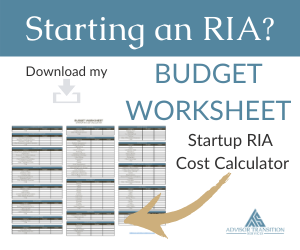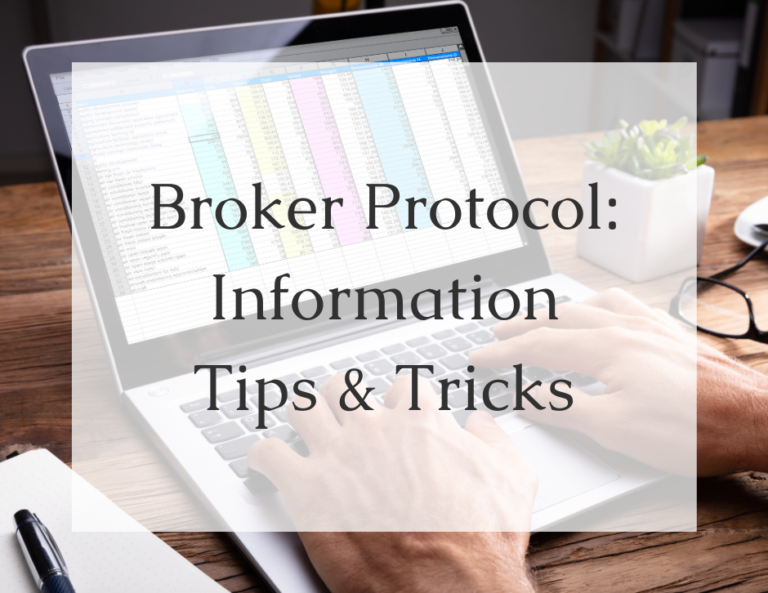When it comes to advisor transitions, especially when leaving a wirehouse to start or join an RIA, there are a number of things to consider. I recently read a great article written by an advisor that listed 26 steps taken to set up and launch an independent RIA. It was a thorough list with information concerning legal structures, compliance, websites, logos, billing options, and more. However, the author didn’t touch on the actual process of transitioning client assets.
So, it got me thinking. How many steps are involved in the actual transition? Using knowledge I’ve gained from my years of experience as a transition consultant, I decided to try and generate my own list. These steps will not apply to all situations in which an advisor is considering a change, but it’s a good starting point for understanding the amount of work that goes into the process.
I’ll start with pre-transition preparation items. Things you can do before you leave your current firm.
Pre-Transition Period
Step 1: Research
Make sure you know the rules and regulations concerning your particular situation. Does the firm you currently work for participate in the Broker Protocol? That makes a huge difference, and you’ll want to know the answer to that question to ensure you know how best to proceed going forward. The Broker Protocol allows you to take specific client information with you when you leave, including client names, addresses, phone numbers, email addresses, and the account titles for their investment accounts (but no other information); by contrast, when leaving a non-Broker Protocol firm, it’s not permissible to take any client information. Leaving a Protocol firm is considered easier than the alternative – since you at least get to bring your basic client contact and other information –but with only five data points on file even from a Protocol firm, the process is still extremely demanding. Consult an attorney or compliance expert for a better understanding of exactly what you can and cannot do in your specific situation.
If you’ve already chosen your new platform or custodian, lean on their expertise. Ask a lot of questions about the transition process to actually move client accounts to their platform, and what level of support will be offered to you (as some custodians provide supplemental assistance for the transition, especially for larger breakaway practices, including help with the bulk paperwork and transfer forms).
If you haven’t chosen a platform or custodian, consider using a placement firm. Recruiting/placement firms exist to evaluate your business, and help match you to the right RIA custodial partner that best fits the needs of your particular practice and clientele.
Step 2: Information Gathering
The amount of information that you’re allowed to bring with you (if any) to your new firm will depend on the previously mentioned Broker Protocol. Keep that in mind when reading these steps. For my purposes, I’m going to assume that you can bring the basics: client names, addresses, phone numbers, email addresses, and account titles. Though ultimately as you contact clients to begin the transition process after you leave, there will be a lot of additional information you’ll need to gather and populate anew (since you can’t bring it with you). See here for a sample list of all the information you’ll eventually need to get.
To keep track of it all, create a master spreadsheet that lists all the fields and information you will eventually need to facilitate all the client account transfers; even if you can’t fill it all in yet, this will become your central resource to track and manage the process. Most custodians have templates you can use. I use one master spreadsheet with all account information stored on one tab, and client information stored on another, which I created for myself and you can download it here.
Having a master spreadsheet to track and manage all of this information, and where each client is in the transition process, will save you valuable time in the future. I will reference the master spreadsheet in many of the next steps.
Transition Preparation Period
Step 3: Create a Schedule
Create a schedule and make a list of tasks you need to complete as you go through the transition process. Don’t know where to start? You can start with the outline of this article.
Assign a date of completion goal to each of the tasks, centering the timing around your proposed resignation date, as once you pull the trigger on your resignation, the race will be on to transition your clients quickly – not only to bring them along before your prior firm competes to retain them, but also simply because you don’t get paid and generate new revenue in your new RIA business until the clients actually transition with you (and you can bill them)!
Keeping a running list of your open transition tasks is good practice, especially if adjustments to the timeline need to be made.
Step 4: Write Out a Client Conversation Script
This step might seem trivial, but I implore you to consider it. Know what you want to say to your clients when you call them to explain your decision to move. Write it down. Because even the strongest client bonds can be tested by major change. Especially since your obligation to your prior firm, as long as you’re still employed there, means you can’t even tell or warn your clients that you might be leaving until you have already left!
In addition, consider the fact that you’re asking clients to erase all their account history, change the website and login credentials they use to view their accounts, and learn to decipher a new statement. For some, that may not be a problem. But, how can you be sure? And do you want to risk finding yourself tongue-tied when they start to raise their concerns? List some reasons for leaving your current firm, as well as reasons for choosing your new one. Think of as many questions as you possibly can that a client might ask. Then answer all of them. In my experience, the 10 most common transition-related questions that clients ask are:
- Why did you decide to leave [Prior Firm], and why didn’t you tell us it was going to happen ahead of time?
- Why did you choose [New Firm], and what can you tell me about its track record?
- How long will my accounts take to transfer over, and how will I know when it’s done?
- What happens to all my account history? Will my cost basis transfer?
- Why do I need to provide all my personal and financial information to you again?
- Why are advisors from [Prior Firm] calling me? Is what they’re saying true?
- Who do I call if you’re not available? What happens when you’re on vacation?
- What happens to my accounts if something happens to you?
- Will my periodic transactions be interrupted? How do I make sure I get my money?
- Will my fee change? How and when will my accounts be billed?
The last thing you need is for a client to get spooked because you hesitated on one of these common transition questions that clients ask.
I helped a team of advisors establish an RIA once, and one of the clients asked what would happen to her money if the building we worked in blew up and all of us died. No joke. The advisor laughed off the question… but the client sent us a hand-written note a week later explaining her decision to keep her accounts with the prior firm. Would her decision have been different if the advisor had explained that the assets were custodied at a national firm like Schwab or Fidelity or TD Ameritrade or Pershing, and our unfortunate deaths would have no impact on her financial situation? I have no idea, but a confident answer, instead of an awkward laugh, certainly might have come across better.
Breakaway advisors sometimes underestimate the perceived financial security clients associate with big-name firms. It’s important to discuss how RIA custody works and talk about the strength of your new custodian.
Step 5: Create a List of Paperwork for Initial Client Mailings
You might think that transferring assets is as simple as a client signing a transfer form, but it’s not the case when doing it as part of a transition.
Instead, you must first open all the accounts, and satisfy those paperwork requirements, then submit the transfer forms, and then provide any outside documentation the client is required to sign or receive.
Aside from the custodian’s paperwork to open and transfer accounts, you also need to provide the client with your investment advisory contract, ADV, and privacy policy (as remember, they may be continuing to work with “you” but it’s an entirely new business relationship at this point). In fact, you will likely want to include information about the custodian, and marketing materials about your own firm, when you ultimately send the paperwork out to clients.
When creating your list of client packet materials, consider adding a letter to the client (sample here), instructions for completing forms (sample here), account opening documents, a list of required account supporting documentation (trust agreements, death certificates, POA paperwork, etc), account transfer forms, investment advisory contract, financial planning contract, ADV, privacy policy, forms for additional account features, new business cards, and marketing materials for you and your RIA custodian.
Step 6: Draft a Letter of Resignation
A letter of resignation is generally required when leaving a firm. I suggest keeping it short and simple. Be polite. This document gets filed by your former firm and can be used against you.
A resignation letter is not the best tool for burning bridges. Be smart. See a sample letter here.
Step 7: Draft a Letter to Your Clients
Even if a letter will not be the first contact your client receives from you (because you’re planning to call all your clients as soon as you officially hand in the resignation letter), you should still have a client letter ready to send.
The first few days after you resign from your firm can be stressful and time-consuming. Sometimes, all you have time for is a quick phone call with a client about your decision. During the conversation, you can reference the letter and packet the client will receive shortly in the mail, as a way to expedite the discussion and allow more time to reach out to the other clients.
Use the letter to explain your decision to clients in full detail. Express the importance of the relationship you have and remind them how well you’ve served them up to this point. Don’t use negative language about your prior firm, though. Remember that their assets remain there until they initiate a transfer. Chances are, someone will reach out to them and attempt to retain their business. Possibly before you’ve even had a chance to speak with them. That person may even say negative things about you. Take the high road (as most people respond better to positivity anyway). See a sample letter here for a starting point.
And be certain to include all your new firm and personal contact information in the client letter. Again, your clients are in a new business relationship with you. It won’t be good if they decide they do want to transition with you, and then have to contact your prior firm because they don’t know how to reach you!
Step 8: Draft a Letter for Your Clients to Send to Your Prior Firm
Draft a letter to your prior firm, as though it’s coming from your client to the firm. Include it in the packet for your client to sign and send, along with a statement that makes it clear to the prior firm that the client intends to transfer their accounts. Although hopefully not necessary, this letter can be especially helpful if the prior firm is being hostile in any way and is trying to block or slow outbound client transfers that you’re requesting. As while the firm may want to antagonize you as the departing broker, they are required to follow client instructions.
You can use this sample client letter as a template.
Step 9: Research the Account Opening and Transfer Process of Your New Firm
In general, the account opening and transfer process is similar for most custodians in the independent space. However, there are significant differences in the details.
For example, when opening a new account at TD Ameritrade, one only needs to submit the client-signed new account form and the back office processes the request, opens the account, and provides the new account number. Transfer forms can be submitted with the new account paperwork and will be processed as soon as the accounts are open.
At Raymond James, advisors and branch personnel are responsible for opening new accounts. However, they can do so without any paperwork or client signatures, and the system will generate the completed forms to be signed within 30 days of account opening. Transfer forms can be submitted as soon as the accounts are open, even if the new account forms haven’t been returned.
The importance of this distinction is that with TD Ameritrade, your time will be spent filling out new account paperwork and sending it to clients for quick turnaround to then start the transfer process. By contrast, with Raymond James, your time will be spent gathering client information to open the accounts as placeholders and only then following up with clients for all the paperwork.
The differences in process guide your course of action. By asking your custodian pointed questions about the process, you can plan how you will handle the workflow and where the bulk of your time will be spent.
Step 10: Create a Client Information Gathering Sheet
As discussed earlier, there’s a wide range of potential information you may need to gather to actually facilitate the account opening and transfer process. Now that you’re in the final stages of preparation, it’s time to create a Client Information Gathering Sheet for every client (see a PDF example here or download my Excel template to create your own).
While the reality is that you can simply gather the information from clients as you enter it into the various new account and transfer forms, custodian paperwork can be lengthy, confusing, and filled with pages of disclosures. The clients still need to sign the documents with pages of disclosures, but by creating a streamlined, aesthetically pleasing version of a Client Information Gathering form, you have an easy way to collect and record information. In fact, you will likely be referencing it often while completing the new account forms and account opening and transfer processes. And a polished Client Information Gathering Sheet can be easily sent to clients for them to complete on their own time, instead of relaying all the information to you over the phone during your potentially-hurried calls announcing your transition.
You can also use the Client Information Gathering Sheets to fill in the fields of your master spreadsheet, so you can keep track of your progress through each part of the process.
Step 11: Game Plan Your Client Packets
Now that you know what your workflow will consist of in terms of account openings and transfer forms, you can game plan the process of sending client packets.
Some custodians will generate client account forms for you, but that results in numerous empty fields on the forms that need to be filled in by someone anyway.
Some advisors choose to send the forms to clients as is, and have them fill in the missing information… though in my experience, that approach has the highest failure rate in terms of completion and client satisfaction.
Other advisors choose to gather the missing information from clients, fill it in themselves, and then send the completed forms. That option has a higher likelihood of success, but it requires a significant up-front time commitment with staff members dedicated to hand-written data entry.
Ideally, the most efficient way to handle the process is to gather all the necessary information onto one spreadsheet and populate the completed forms in bulk. Though since you don’t own your (prior firm) client information, and have only limited information you can bring even under the Broker Protocol, accomplishing this task is done by filling out the aforementioned Client Information Gathering Sheets first.
As a transition consultant, I’ve used many different methods for this process. One of my favorites is the remote client information gathering method. First, I create a Client Information Gathering Sheet, and then after the advisor resigns, I have him, myself, or another staff member speak to each client over the phone as soon as possible and fill out the sheet. I record what types of accounts need to be opened, and what paperwork is involved. Then I use that sheet to gather everything I need for the client packet. Whether I’m opening the accounts and generating the forms, filling out the forms myself, or running a program that fills the forms for me, I can do everything I need all at once.
Electronic signatures are another popular choice for paperwork. The process is faster and more convenient for the advisor and client. However, you must consider all the other paperwork that cannot be sent using an e-sign system like DocuSign. Most firms won’t allow you to include your investment advisory agreement on their e-sign platform. Some will for an additional fee. What about all the other paperwork mentioned in Step 5? The letter to your clients? Your ADV and privacy policy? E-sign is a great way to get things signed quickly. It just isn’t always the best way to handle all of the re-papering of accounts during a transition.
Regardless of the method you use, lean on your master spreadsheet, updating as you go. Add columns for status updates that reflect the different stages of processing: paperwork sent to client, paperwork returned, processing, accounts opened, ACATs submitted, funds transferred, suspended, rejected, needs action, or complete. Insert a column for tracking numbers if you’re sending packets by priority mail or overnight. Keeping up-to-date records saves you time and keeps everyone on the same page.
Transition Period
Step 12: Hand in Your Resignation Letter
I wrote briefly about this in Step 6, but feel the need to reiterate: for the sake of both your clients and your own career, try not to burn bridges. Hand in your resignation letter and leave the scene (and you will likely be escorted from it anyway). Remember, your client accounts remain where they are until you’re able to transfer them. They will be assigned to other advisors at the branch almost immediately. You have no control over who will contact them, and what tactics they’ll employ to retain the business.
I recently worked with an advisor who resigned from the RIA he’d been employed by to establish his own. The firm he left chose not to honor their own non-solicitation agreement and sent an email to all his clients and implored them to consider staying with the firm. While most of his clients dismissed the communication, his largest clients hesitated, referenced several points made in the email, and initiated an “evaluation” of their financial situation. The prior firm continued to slander the advisor. Ultimately, the advisor was eventually able to convince his clients to join him… and attributes the success to his continued professionalism and positivity throughout the process (while the clients disliked the negative behavior of the prior firm’s efforts to retain them).
In addition, the way you choose to exit your current position could have a ripple effect. Consider possible legal ramifications. If you’re leaving a wirehouse, you’re dealing with an entity that has deep pockets and little empathy. Tread lightly, and stay on the high ground. Hand in your (simple) resignation letter, and just leave.
Step 13: Start Talking to Your (Former) Clients
After you resign, immediately start communicating with your (former but hopefully-to-be-retained) clients.
Many advisors choose to resign at the end of a work week and/or before a holiday weekend, so they can get a head start on speaking with clients. The theory is that the management team at the firm they are leaving will realistically not be able to reassign the accounts to new advisors until the start of the following week, especially if the resignation letter is handed in at the very end of the business day on Friday (when often most of the other brokers have already left early for the weekend).
Ideally, the exiting advisor will have spoken to the majority of (if not all of) the clients by the time the newly assigned advisors from the prior firm start making their introductory calls the following week.
I think the tactic is smart. Having time to explain your situation, and warn your clients that they will receive calls from other advisors at the former firm, can be crucial in the overall process. You want your clients to hear the story from you first, which allows you to better control the narrative.
Know the specific rules you need to follow when contacting clients, though. In particular, if you’re not supposed to solicit (i.e., you have a non-solicit agreement), don’t do anything that can be considered solicitation. In particular, don’t send out client packets for signatures before speaking with clients if you’re subject to a non-solicit.
Contacting clients can also be difficult, especially when leaving non-Protocol firms, because you’re not able to bring any client information with you. Which simply means you’ll have to find other means of getting it, like accessing public records for contact information.
In addition, be certain to update your social media accounts, so your clients can easily find their way to you. Add your new phone number, email address, and website as soon as possible. Post a message about your transition to the new firm, and invite your contacts to learn more about your decision to leave.
Once your clients start asking how to join you, initiate your game plan from Step 11. Have plenty of Client Information Gathering Sheets on hand. Start filling in your master spreadsheet.
Step 14: Get into a Groove
Initiate all your game plans, and start finding your groove. Even when it all goes well, there’s still a lot to get through in a large-scale transition of clients.
Process items in bulk when you can (and always record all details on your master spreadsheet). Mail out packets in groups. Open new accounts or submit forms in batches. Designate team members for specific tasks that they can learn and then repeat efficiently.
If you get 10 client packets returned in the mail at the same time, process them all at the same time. Start by checking the paperwork for completion, then open the accounts and/or process the forms together. File everything neatly, and update the master spreadsheet with the changes in status for each account.
In the beginning, things are stressful and chaotic. By streamlining processes and completing tasks in bulk, you can better reference the status of individual items at later dates, increase productivity, and eliminate downtime.
Helpful Tip: Purchase and download the Pro version of Adobe Acrobat. It allows you to scan large batches of paperwork, and organize and split the pages as needed. It can be downloaded as an app on your phone, so you can take photos, turn them into PDFs, and upload them to the cloud so you can access them from any of your devices to submit for processing. It also allows for more efficient remote assistance if all your team members are not in the same physical location.
Step 15: Update Your Master Spreadsheet First Thing Every Morning
Start each day by referencing and updating your master spreadsheet. Use it as your lifeline. Continue updating it throughout the day as you check things off your list.
Oftentimes, things fall through the cracks. Issues crop up. Paperwork gets misplaced. Transfers process overnight. Being able to check each individual account status every morning in one place allows you to have complete control over your workflow during the day.
Helpful Tip: Use conditional formatting in Excel to color code each of your accounts based on status (see an example in column E of the sample master spreadsheet). YouTube has some great video resources and tutorials for learning new tricks in Excel as well.
Step 16: Keep a Running List of Clients Who Haven’t Returned Paperwork
Use your master spreadsheet to determine which clients haven’t returned paperwork.
There’s only so much you can do once the paperwork is sent. You must rely on clients to do their part as well. They could be reluctant to rush the process, because of the disruption that the adjustments will have in their own lives. But you don’t want to have their delays cause transfers to slip through the cracks.
By keeping a list, you can keep up constant communications. Remind them that you’re the reason they’re making the change, and your relationship with them is important.
Step 17: Send Status Updates
The time-consuming nature of a major transition puts a strain on you and causes an interruption in regular business operations and communications. But transitions can be taxing for clients, too. The stress and time-consuming aspects of the process for the client can easily damage a relationship even if it goes smoothly, and especially if it does not. At a minimum, clients are often left wondering how long the transfer will take, and what to expect.
By proactively providing them status updates, you can eliminate client worries. Let them know when paperwork is on its way, and what the expected delivery date is. Tell them when you’ve received it, and what the estimated processing time frame is. Send them a note when the funds transfer.
This is also a great time to get clients set up with online access to the RIA custodian, so they can log in and see their accounts. The updates also serve to keep you informed, and remind you which clients are exiting the transition phase and beginning to resume regular operations.
The Takeaways of Planning a (Smooth) Transition
These 17 steps I came up with include a fair amount of advice and helpful tips, but I’d like to offer some additional thoughts to bear in mind as you prepare for the transition process.
1. Do your research.
I cannot stress this point enough. Know what you’re getting yourself into and how you’re going to handle it. Ask as many questions as possible. Seek out others who’ve recently gone through what you’re about to go through (ideally who left your firm in particular). Be as detailed as possible. Issues stemming from insufficient preparation are totally preventable.
2. Staff appropriately.
Trying to complete a transition on your own is ill-advised.
Find out what resources your new RIA custodian or accepting firm can offer.
Consider hiring a transition consultant or part-time staff member to supplement your team during those initial first few weeks when there’s a burst of administrative work.
If you’re planning to employ full-time staff, consider doing so prior to the onset of the transition paperwork itself (though you may have to wait until your Resignation is official to make their hire official).
At a minimum, designate someone as the “Project Manager”. Divvy up the workload based on individual strengths. And know your own limitations.
3. Stay organized.
Things can spiral out of control quickly when attempting to move a large group of client accounts all at once.
Keep updated records of your progress. Create physical client files, as well as digital ones. Consider using a secure file-sharing tool, like ShareFile, that clients can access to upload statements and forms.
Spend some extra time keeping things organized. It will end up saving you more time in the long run.
4. See the big picture.
Transitions take a long time, but they don’t last forever. Keep a clear head and remember that the process is temporary. Depending on the number of households you plan to move, and the complexity of each account, transitions can last several weeks to several months, and the beginning is always busiest.
But at some point, after that initial flurry of activity, you’ll begin to resume normal business operations.
Hopefully, you’ll be in a better situation than you were prior to the transition, and you’ll never have to worry about going through the process ever again.
Conclusion
Transitions suck. There’s no other way of putting it. Many advisors fear the process and rightfully so. It’s time-consuming, stressful, and expensive, even when it goes well (and especially when it doesn’t).
On the other hand, a transition is the catalyst for an amazing and successful career as an entrepreneur. Most advisors who make a transition to independence do so with the desire to better control the way their clients are served. It can help you attain a new level of freedom, and significantly increase your upside potential.
And the more you prepare for the transition, the easier it will be to get through to the opportunities on the other side.
“Nothing in this world is worth having or worth doing unless it means effort, pain, difficulty.”
Theodore Roosevelt




